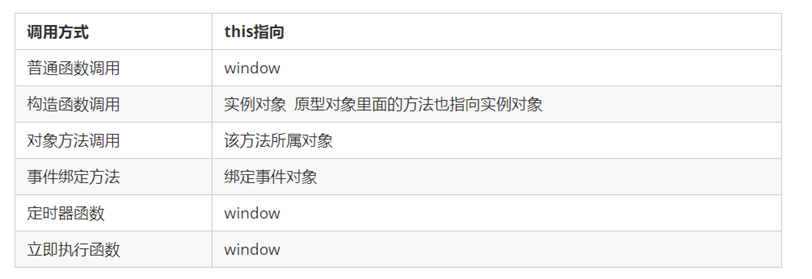关于 this 指向的理解
Created|Updated
|Word Count:1.3k|Reading Time:5mins|Post Views:
函数内 this 的指向
这些 this 的指向,是当我们调用函数的时候确定的。
调用方式的不同决定了this 的指向不同一般指向我们的调用者. 
1. 普通函数 this 指向window
1
2
3
4
| function fn() {
console.log('普通函数的this' + this);
}
window.fn();
|
2. 对象的方法 this指向的是对象
o
1
2
3
4
5
6
| var o = {
sayHi: function() {
console.log('对象方法的this:' + this);
}
}
o.sayHi();
|
3.
构造函数 this 指向 ldh 这个实例对象 原型对象里面的this 指向的也是
ldh这个实例对象
1
2
3
4
| function Star() {};
Star.prototype.sing = function() {
}
var ldh = new Star();
|
4.
绑定事件函数 this 指向的是函数的调用者 btn这个按钮对象
1
2
3
4
| var btn = document.querySelector('button');
btn.onclick = function() {
console.log('绑定时间函数的this:' + this);
};
|
5. 定时器函数 this
指向的也是window
1
2
3
| window.setTimeout(function() {
console.log('定时器的this:' + this);
}, 1000);
|
6. 立即执行函数
this还是指向window
1
2
3
| (function() {
console.log('立即执行函数的this' + this);
})();
|
改变函数内部 this 指向
JavaScript 为我们专门提供了一些函数方法来帮我们更优雅的处理函数内部
this 的指向问题,常用的有 bind()、call()、apply() 三种方法。
1. call 方法
call()
方法调用一个对象。简单理解为调用函数的方式,但是它可以改变函数的 this
指向。
1
| fun.call(thisArg, arg1, arg2, ...)
|
thisArg:在 fun 函数运行时指定的 this 值
arg1,arg2:传递的其他参数
返回值就是函数的返回值,因为它就是调用函数
因此当我们想改变 this 指向,同时想调用这个函数的时候,可以使用
call,比如继承
1
2
3
4
5
6
7
8
9
10
11
12
13
14
15
16
17
18
19
20
21
22
23
| var o = {
name: 'andy'
}
function fn(a, b) {
console.log(this);
console.log(a + b);
};
fn.call(o, 1, 2);
function Father(uname, age, sex) {
this.uname = uname;
this.age = age;
this.sex = sex;
}
function Son(uname, age, sex) {
Father.call(this, uname, age, sex);
}
var son = new Son('刘德华', 18, '男');
console.log(son);
|
2. apply 方法
apply()
方法调用一个函数。简单理解为调用函数的方式,但是它可以改变函数的 this
指向。
1
| fun.apply(thisArg, [argsArray])
|
thisArg:在fun函数运行时指定的 this 值
argsArray:传递的值,必须包含在数组里面
返回值就是函数的返回值,因为它就是调用函数
因此 apply 主要跟数组有关系,比如使用 Math.max() 求数组的最大值
1
2
3
4
5
6
7
8
9
10
11
12
13
14
15
16
17
18
19
| var o = {
name: 'andy'
};
function fn(arr) {
console.log(this);
console.log(arr);
};
fn.apply(o, ['pink']);
var arr = [1, 66, 3, 99, 4];
var arr1 = ['red', 'pink'];
var max = Math.max.apply(Math, arr);
var min = Math.min.apply(Math, arr);
console.log(max, min);
|
3. bind 方法
bind() 方法不会调用函数。但是能改变函数内部this 指向
1
| fun.bind(thisArg, arg1, arg2, ...)
|
thisArg:在 fun 函数运行时指定的 this 值
arg1,arg2:传递的其他参数
返回由指定的 this 值和初始化参数改造的原函数拷贝
因此当我们只是想改变 this 指向,并且不想调用这个函数的时候,可以使用
bind
1
2
3
4
5
6
7
8
9
10
11
12
13
14
15
16
17
18
19
20
21
22
23
24
25
26
27
28
29
30
31
32
33
34
| var o = {
name: 'andy'
};
function fn(a, b) {
console.log(this);
console.log(a + b);
};
var f = fn.bind(o, 1, 2);
f();
var btns = document.querySelectorAll('button');
for (var i = 0; i < btns.length; i++) {
btns[i].onclick = function() {
this.disabled = true;
setTimeout(function() {
this.disabled = false;
}.bind(this), 2000);
}
}
|
call apply bind 总结
相同点
都可以改变函数内部的this指向.
区别点
call 和 apply 会调用函数, 并且改变函数内部this指向.
call 和 apply 传递的参数不一样, call 传递参数 aru1, aru2..形式 apply
必须数组形式[arg]
bind 不会调用函数, 可以改变函数内部this指向.
主要应用场景
call 经常做继承.
apply 经常跟数组有关系. 比如借助于数学对象实现数组最大值最小值
bind 不调用函数,但是还想改变this指向. 比如改变定时器内部的this指向.

